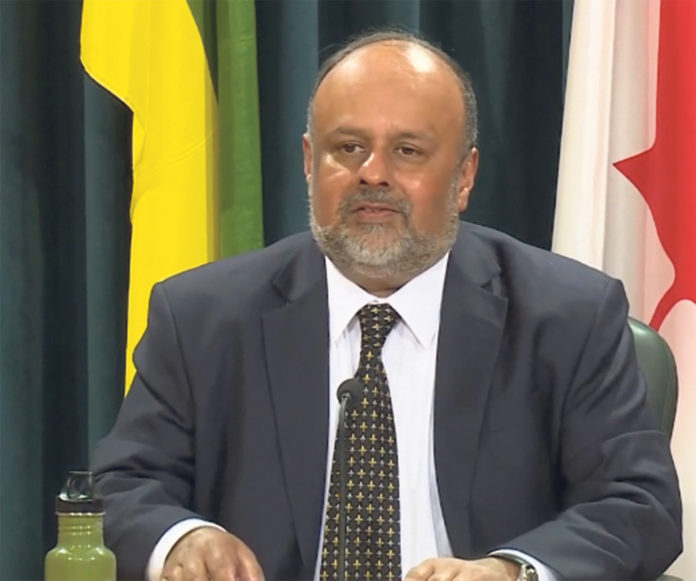
The province is nearly three weeks behind other jurisdictions in the spread of the omicron variant of COVID-19, according to the province’s top doctor.
Chief medical health officer Dr. Saqib Shahab said that Saskatchewan is likely to see the peak of the wave in two to three weeks, which the surge lasting the next six to eight weeks. Shahab said on Tuesday that the Omicron variant’s rapid spread will worsen chronic conditions in people with diabetes, heart disease and other long-term illnesses who then may require hospitalization.
“Underlying chronic conditions as well as COVID will drive an increase in hospitalizations,” Shahab said during the Provincial Emergency Operations Centre media briefing on Tuesday.
“This is a bit different from the pure COVID lung disease, but we will see an increase in the next six to eight weeks and have to prepare for that.
“Hospitalizations peak after an one to two week lag. So unfortunately, we will see an increase in hospitalizations continuing over the next six weeks. And some of those hospitalizations will be in individuals with COVID like illness but lower pressure on ICU but there will still be some pressure,” Shahab said.
He explained further that the peak will come in larger centres to start.
“We have to remember that Saskatchewan is one to three weeks behind other provinces in our omicron surge and we have seen from other provinces that while we expect to peak in our case numbers over the next two to four weeks starting in Regina and Saskatoon,” he explained.
Shahab’s update also included a presentation of provincial data on vaccinations and breakthrough infections from Dec. 1 to 31, 2021. The data overall showed that vaccinations kept people out of hospital.
Statistics presented by Shahab from the month of December found unvaccinated residents were almost nine times as likely to spend time in the ICU because of COVID-19 relative to their vaccinated neighbours, at a rate of 3.5 people per 100,000 residents compared to 0.4 per 100,000 in the vaccinated population.
“For December we were coming out of our Delta surge,” Shahab said. “The omicron surge hadn’t really picked up, so we overall saw a low number of hospitalizations mostly in the unvaccinated. The (case) rate again was higher in (those who were) unvaccinated, with lower rates in people that were vaccinated,” Shahab said.
Unvaccinated people were a more than twice as likely to spend time in hospital. The data presented showed a rate of nine per 100,000 compared to 3.7 per 100,000 among fully vaccinated people.
The ICU admissions showed a similar success in vaccinations.
“We had about 15 ICU admissions in December on this analysis,” Shahab said. “Again, the risk is higher in unvaccinated and lower if you were fully vaccinated or boosted, and again, only three ICU admissions in people who were vaccinated. Two had comorbid conditions and two were over 65 years of age.”
Shahab explained that the omicron variant is understood to cause less severe sickness than the Delta variant that was the main variant during the fall months. He added that it is far more transmissible and infects vaccinated people much more readily.
While unvaccinated people are still at much higher risk, he said infection with the variant could “tip the balance” in people who are vulnerable, which will be cause them to spend time in hospital.
“Omicron may cause a different presentation, especially in those who are fully vaccinated, with lower requirement for ICU care,” Shahab said.
There were seven deaths related to COVID-19 in December—four in those were unvaccinated and three who had two doses. Of those three with two doses, two were patients ages 55 and older, while the other patient had an underlying risk factor.
Shahab explained that as far as vaccinations are going, the province is in relatively good shape. According to the most recent update, 85 per cent of those eligible have first and second doses. Shahab said that booster dose uptake is good in the 60 and over category.
“We really want booster uptake to go up for everyone 18 and older as long as they are three months out to their second dose. Increased booster uptake will decrease the pressure on hospitals,” he said.
At this point booster uptake is highest in Regina and Saskatoon.
Shahab said the booster dose is critical, but people should also continue with best practices such as staying home when they are sick and using the best mask when in public.
“Using all of the other tools we have been using over the last two years especially during the next four to six weeks when we will likely peak or the next two to three weeks with our omicron surge and that can take another three to four weeks to come with our omicron surge,” Shahab said.
Michael.oleksyn@paherald.sk.ca

